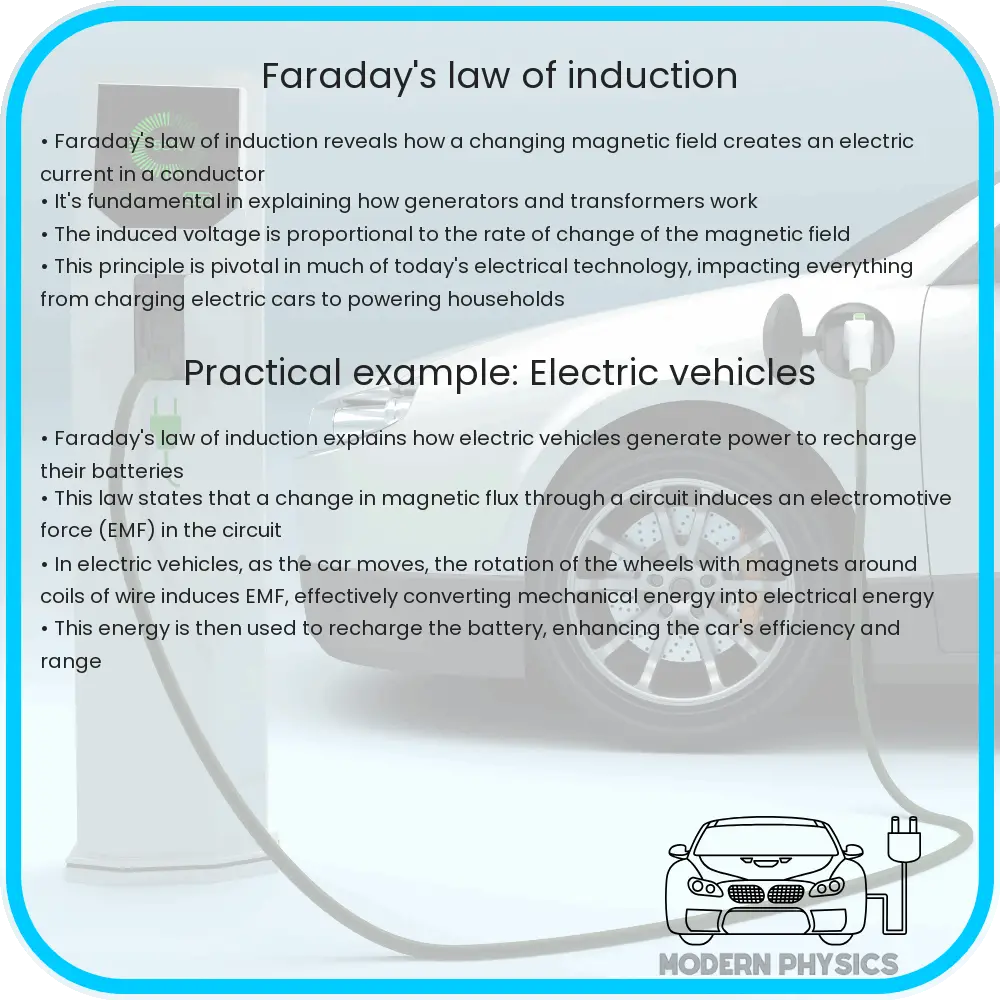Explore Faraday’s Law of Induction: its principles, applications in modern tech, environmental impact, and future prospects in electromagnetism.

Understanding Faraday’s Law of Induction
Faraday’s Law of Induction, named after the English scientist Michael Faraday, is a fundamental principle of electromagnetism predicting how a magnetic field will interact with an electric circuit to produce an electromotive force (EMF). This discovery has immense implications in modern technology, influencing the design and functioning of various electrical devices.
Principles of Faraday’s Law
The core principle of Faraday’s Law is that it quantifies the EMF produced when the magnetic environment of a circuit changes. Faraday’s Law can be stated as:
“The induced electromotive force in any closed circuit is equal to the negative of the time rate of change of the magnetic flux through the circuit.
This phenomenon can be observed in two scenarios: when a magnetic field changes within a stationary conductor or when a conductor moves through a stationary magnetic field. The induced EMF (E) can be mathematically expressed as:
E = -dΦB/dt
where ΦB is the magnetic flux through the circuit and dΦB/dt is its rate of change with time. The negative sign represents Lenz’s Law, indicating that the induced EMF and the change in flux have opposite signs.
Applications of Faraday’s Law
Faraday’s Law is the cornerstone of many electrical devices and systems. Its applications include:
- Generators: In generators, mechanical energy is converted into electrical energy by rotating a coil within a stationary magnetic field, thus inducing EMF.
- Transformers: Transformers use Faraday’s Law to convert voltages from one level to another. A changing magnetic field in the primary coil induces a varying magnetic field in the secondary coil, thus transferring energy.
- Induction Motors: These motors use electromagnetic induction to convert electrical energy into mechanical motion.
Insights into Faraday’s Law
Faraday’s Law is a testament to the unification of different forces of nature. It demonstrates the relationship between electricity and magnetism, paving the way for Maxwell’s equations. These insights have revolutionized our understanding of electromagnetic phenomena and their practical applications.
In summary, Faraday’s Law of Induction is not just a scientific principle; it is a fundamental cornerstone that has shaped modern electrical engineering and technology. Its implications extend far beyond its initial discovery, influencing numerous aspects of contemporary life.
Further Insights and Modern Developments
Advancements in the understanding and application of Faraday’s Law continue to emerge. For instance, in the field of wireless charging, Faraday’s principles are employed to transfer power without physical connections. Similarly, in medical imaging technologies like MRI (Magnetic Resonance Imaging), Faraday’s Law plays a crucial role in the generation of images using changes in magnetic fields.
Another significant application is in the area of electromagnetic induction sensors, used in various fields from vehicle detection to metal detection. These sensors exploit the principles of Faraday’s Law to detect changes in electromagnetic fields, offering a wide range of practical uses.
Environmental Impact and Sustainability
Faraday’s Law also has implications for environmental sustainability. In renewable energy systems, such as wind turbines and hydroelectric generators, the law’s principles are fundamental in converting natural kinetic energy into electrical energy. This transition towards clean energy sources highlights the enduring relevance of Faraday’s discovery in addressing modern environmental challenges.
Challenges and Future Prospects
Despite its wide applications, there are challenges in maximizing the efficiency of technologies based on Faraday’s Law, particularly in energy conversion and transmission. Ongoing research in material science and engineering aims to address these challenges, potentially leading to more efficient and sustainable energy solutions.
The future of Faraday’s Law seems intertwined with the evolution of smart grids and advanced power systems, where it will play a pivotal role in the efficient distribution and management of electricity.
Conclusion
Faraday’s Law of Induction remains a pillar in the field of electromagnetism, holding a place of honor in both historical context and modern application. Its discovery has not only deepened our understanding of the natural world but also spurred countless innovations that have shaped the landscape of modern technology. As we continue to explore and harness the power of electromagnetic fields, Faraday’s insights will undoubtedly continue to influence and inspire future generations of scientists and engineers. The enduring legacy of Faraday’s Law is a testament to the profound impact that fundamental scientific discoveries can have on our world, driving progress and innovation across diverse fields.
